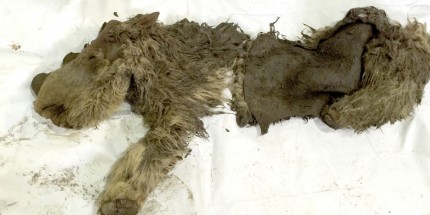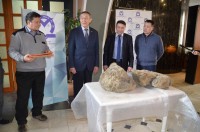Two hunters have discovered the exceptionally well preserved remains of a baby woolly rhinoceros in the Abyysky district of Siberia’s Sakha Republic. The Siberian permafrost is a rich source of pre-historic skeletal and fossil finds, but on rare occasions the deep freeze is found to have preserved the carcasses of fallen Pleistocene animals in such good condition that even soft tissues survive. While bison and mammoths have been found before (female mammoth, two baby mammoths, juvenile mammoth), this is only the second time a woolly rhinoceros has been found frozen rather than mummified or skeletonized, and it’s the first woolly rhinoceros calf that has ever been found in any condition beyond the occasional bone.

The little fella was first spotted by hunters Alexander “Sasha” Banderov and Simeon Ivanov (the Siberian Times made a rather unfortunate error in translating Ivanov’s first name) when they were sailing on a stream flowing into the Semyulyakh River last summer. They saw some hair hanging from the top of a ravine on the right bank. At first they thought it was the remains of a reindeer, but they couldn’t confirm or deny because the carcass was far out of their reach. When they returned to the spot in September, the ice had thawed and the section of frozen earth containing the remains had thawed enough to break off and fall onto the river bank. Although a section of the carcass sticking out of the ice had been devoured by wild animals (there are visible teeth marks), the head was intact and its two horns immediately identified it as a rhinoceros.
Banderov and Ivanov retrieved the rhino and carried it home to their village where they placed it in a glacier to keep it frozen. Knowing that scientists would want to examine this remarkable find, they contacted Albert Protopopov, head of the Mammoth Fauna Department of the Academy of Sciences of the Republic of Sakha, Yakutia. It took almost six months to get the carcass 1,800 miles away to Yakutia due to the challenges inherent in transporting anything across vast distances in the Siberian winter.
 On February 25th, the Academy held a press conference announcing the discovery, its arrival in Yakutia and its name: Sasha, after one of the hunters who found it. Protopopov emphasized what a unique opportunity they have to study a baby woolly rhinoceros. Before now they hadn’t even had the chance to examine a single tooth from a woolly rhino calf, never mind a complete skull and head with a surviving ear, eye, nostrils and mouth. There is also copious surviving wool and two legs with intact hooves. (The parts in the middle were eaten.)
On February 25th, the Academy held a press conference announcing the discovery, its arrival in Yakutia and its name: Sasha, after one of the hunters who found it. Protopopov emphasized what a unique opportunity they have to study a baby woolly rhinoceros. Before now they hadn’t even had the chance to examine a single tooth from a woolly rhino calf, never mind a complete skull and head with a surviving ear, eye, nostrils and mouth. There is also copious surviving wool and two legs with intact hooves. (The parts in the middle were eaten.)
Although it will take several months to get dating results, Sasha has to be at least 10,000 years old because that’s when the woolly rhinoceros became extinct. Scientists estimate the calf was about 18 months old at the time of death which was probably as a result of falling into a pit.
Mr. Protopopov explained: “Even to find a skull of a baby rhino is very lucky indeed. The possible explanation to it is that rhinos bred very slowly. Mothers protected baby rhinos really well, so that cases of successful attacks on them were extremely rare and the mortality rate was very low. Woolly rhinos are less studied than mammoths. We are hoping Sasha the rhino will give us a lot of answers to questions of how they grew and developed, what conditions they lived in, and which of the modern day animals is the closest to them.”
The team will focus first on extracting DNA from the carcass. Because the hunters were so brilliantly conscientious about keeping Sasha frozen, the odds of the scientists being able to extract testable DNA are better than usual. They hope they’ll be able to report on the first test results in a couple of weeks.
Rarity. Huh. That explains why I’d never heard a single person discuss impregnating a rhino with a wooly rhino, despite the seeming popularity of doing same to an elephant with a mammoth.
Was it clear whether the middle had been eaten in entirely present or ancient time? It would be interesting to have confirmation or disproof of our ideas of what the predatory and scavenger populations looked like while wooly rhinos roamed, if some of the tooth marks could be identified as belonging to ancient diners.
I love how they were able to just place it ‘in a glacier’, which is said as casually as ‘in the freezer’. LOL
Marvelous find indeed! Though it is sad to imagine the poor little rhino’s last hours… (At first glance I thought the photo was of someone’s stuffed toy dog that had been left outside all winter!)
Kudos to the hunters, too; sounds like they handled the whole situation very deftly.
One might wonder how all these huge mammals came to be flash frozen in northern Siberia? It has been estimated to freeze a mammoth solid so that it did not decay a temperature below -200º would be necessary. It has been suggested that only a polar shift could produce the massive cataclysm that froze and buried these animals around the Arctic Circle.